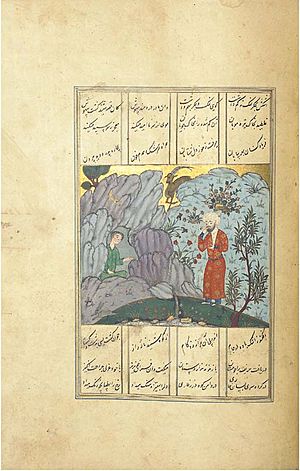Riddles of Amir Khusrow facts for kids
The Riddles of Amir Khusrow are fun puzzles created by a famous poet named Amir Khusrow. He lived a long time ago, during the time of the Delhi Sultanate, a powerful kingdom in India. Khusrow was not only great at making riddles, but he also wrote many songs and stories. These have been popular in South Asia for hundreds of years!
His riddles, songs, and stories are very important because they are some of the earliest examples of the Hindustani language. This language is the base for modern Hindi and Urdu. Khusrow's riddles are especially clever because they use wordplay. This means they often have a double meaning, making them tricky and fun to solve.
For over 700 years, people have shared many of these riddles by telling them to each other, passing them down through what's called oral tradition. This means they were spoken and remembered, not just written in books. Even today, they are becoming more popular! However, some people wonder if Amir Khusrow really wrote every riddle linked to his name. Some riddles talk about things that didn't exist when he was alive, like guns or hookahs.
Contents
What Are Amir Khusrow's Riddles Like?
There are 286 riddles in the main collection. They are grouped into six different parts. These groups are based on how the riddles are put together and how their answers are structured. Even though they are "in the style of the common people," meaning they are easy to understand, most experts believe Khusrow himself wrote them. The riddles also follow a special kind of poetic rhythm called Mātrika metre.
Why Are These Riddles Important?
Fun with Wordplay
Amir Khusrow's riddles are famous for their clever wordplay. They often describe something in a way that makes you think of one thing, but the answer is something completely different! This makes solving them a fun challenge. It's like a game where words have secret meanings.
A Glimpse into History
These riddles give us a peek into what life was like during Khusrow's time. They talk about everyday objects, people, and situations. They also show us how language was used hundreds of years ago.
Keeping Culture Alive
Because these riddles have been passed down through families and friends for centuries, they are a big part of the culture in South Asia. They help keep old traditions and the Hindustani language alive and interesting for new generations.


